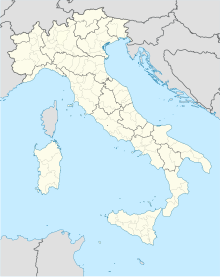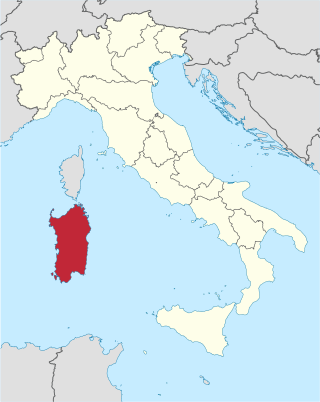
Sardinia is the second-largest island in the Mediterranean Sea, after Sicily, and one of the 20 regions of Italy. It is located west of the Italian Peninsula, north of Tunisia and immediately south of the French island of Corsica.

Archaeological evidence of prehistoric human settlement on the island of Sardinia is present in the form of nuraghes and other prehistoric monuments, which dot the land. The recorded history of Sardinia begins with its contacts with the various people who sought to dominate western Mediterranean trade in classical antiquity: Phoenicians, Punics and Romans. Initially under the political and economic alliance with the Phoenician cities, it was partly conquered by Carthage in the late 6th century BC and then entirely by Rome after the First Punic War. The island was included for centuries in the Roman province of Sardinia and Corsica, which would be incorporated into the diocese of Italia suburbicaria in 3rd and 7th centuries.
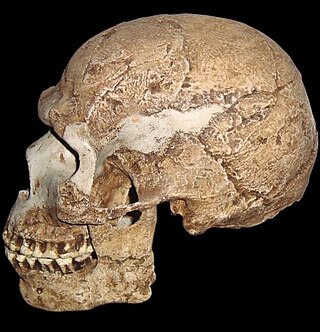
Early modern human (EMH), or anatomically modern human (AMH), are terms used to distinguish Homo sapiens that are anatomically consistent with the range of phenotypes seen in contemporary humans, from extinct archaic human species. This distinction is useful especially for times and regions where anatomically modern and archaic humans co-existed, for example, in Paleolithic Europe. Among the oldest known remains of Homo sapiens are those found at the Omo-Kibish I archaeological site in south-western Ethiopia, dating to about 233,000 to 196,000 years ago, the Florisbad site in South Africa, dating to about 259,000 years ago, and the Jebel Irhoud site in Morocco, dated about 315,000 years ago.

Creswell Crags is an enclosed limestone gorge on the border between Derbyshire and Nottinghamshire, England, near the villages of Creswell and Whitwell. The cliffs in the ravine contain several caves that were occupied during the last ice age, between around 43,000 and 10,000 years ago. Its caves contain the northernmost cave art in Europe. The evidence of occupation found in the rich series of sediments that accumulated over many thousands of years is regarded as internationally unique in demonstrating how prehistoric people managed to live at the extreme northernmost limits of their territory during the Late Pleistocene period.

Africa has the longest record of human habitation in the world. The first hominins emerged 6-7 million years ago, and among the earliest anatomically modern human skulls found so far were discovered at Omo Kibish, Jebel Irhoud, and Florisbad.

The Sardinian pika is an extinct species of lagomorph that was endemic to the islands of Sardinia, Corsica and neighbouring Mediterranean islands until its extinction likely in Roman times. It was last surviving member of Prolagus, a genus of lagomorph once widespread throughout Europe during the Miocene and Pliocene epochs, whose closest living relatives are pikas of the genus Ochotona.
The Middle Paleolithic is the second subdivision of the Paleolithic or Old Stone Age as it is understood in Europe, Africa and Asia. The term Middle Stone Age is used as an equivalent or a synonym for the Middle Paleolithic in African archeology. The Middle Paleolithic broadly spanned from 300,000 to 30,000 years ago. There are considerable dating differences between regions. The Middle Paleolithic was succeeded by the Upper Paleolithic subdivision which first began between 50,000 and 40,000 years ago. Pettit and White date the Early Middle Paleolithic in Great Britain to about 325,000 to 180,000 years ago, and the Late Middle Paleolithic as about 60,000 to 35,000 years ago. The Middle Paleolithic was in the geological Chibanian and Late Pleistocene ages.
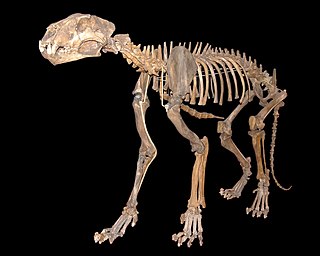
Panthera spelaea, also known as the cave lion or steppe lion, is an extinct Panthera species that most likely evolved in Europe after the third Cromerian interglacial stage, less than 600,000 years ago. Genetic analysis of ancient DNA has revealed that while closely related, it was distinct species genetically isolated from the modern lion occurring in Africa and Asia, with the genetic divergence between the two species variously estimated between 1.9 million and 600,000 years ago. It is closely related and probably ancestral to the American lion. The species ranged from Western Europe to eastern Beringia in North America, and was a prominent member of the mammoth steppe fauna. It became extinct about 13,000 years ago.
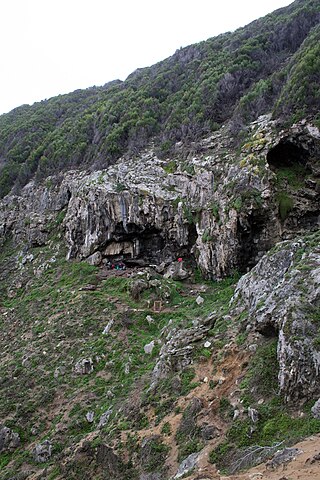
Blombos Cave is an archaeological site located in Blombos Private Nature Reserve, about 300 km east of Cape Town on the Southern Cape coastline, South Africa. The cave contains Middle Stone Age (MSA) deposits currently dated at between c. 100,000 and 70,000 years Before Present (BP), and a Late Stone Age sequence dated at between 2000 and 300 years BP. The cave site was first excavated in 1991 and field work has been conducted there on a regular basis since 1997, and is ongoing.
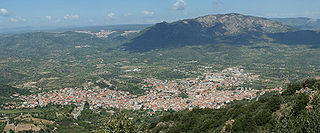
Oliena is a commune in the province of Nuoro, Sardinia, Italy.
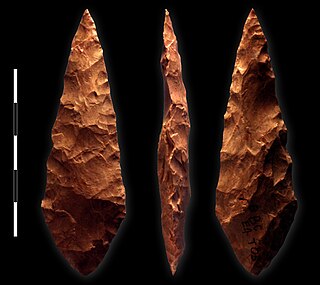
The Middle Stone Age was a period of African prehistory between the Early Stone Age and the Late Stone Age. It is generally considered to have begun around 280,000 years ago and ended around 50–25,000 years ago. The beginnings of particular MSA stone tools have their origins as far back as 550–500,000 years ago and as such some researchers consider this to be the beginnings of the MSA. The MSA is often mistakenly understood to be synonymous with the Middle Paleolithic of Europe, especially due to their roughly contemporaneous time span; however, the Middle Paleolithic of Europe represents an entirely different hominin population, Homo neanderthalensis, than the MSA of Africa, which did not have Neanderthal populations. Additionally, current archaeological research in Africa has yielded much evidence to suggest that modern human behavior and cognition was beginning to develop much earlier in Africa during the MSA than it was in Europe during the Middle Paleolithic. The MSA is associated with both anatomically modern humans as well as archaic Homo sapiens, sometimes referred to as Homo helmei. Early physical evidence comes from the Gademotta Formation in Ethiopia, the Kapthurin Formation in Kenya and Kathu Pan in South Africa.

The Sardinian dhole is an extinct insular canid which was endemic to what is now the Mediterranean islands of Sardinia and Corsica during the Middle-Late Pleistocene. It went extinct at the end of the Pleistocene around the time of human settlement of the islands.

Paglicci Cave is an archaeological site situated in Paglicci, near Rignano Garganico, Apulia, southern Italy. The cave, discovered in the 1950s, is the most important cave of Gargano. The cave is an attraction of the Gargano National Park.

The prehistory of Corsica is analogous to the prehistories of the other islands in the Mediterranean Sea, such as Sicily, Sardinia, Malta and Cyprus, which could only be accessed by boat and featured cultures that were to some degree insular; that is, modified from the traditional Paleolithic, Mesolithic, Neolithic and Chalcolithic of European prehistoric cultures. The islands of the Aegean Sea and Crete early developed Bronze Age civilizations and are accordingly usually treated under those categories. Stone Age Crete however shares some of the features of the prehistoric Mediterranean islands.

The Sardinian long-eared bat is a species of bat endemic to Sardinia, Italy.

Neanderthals, also written as Neandertals, are an extinct species or subspecies of archaic humans who lived in Eurasia until about 40,000 years ago. The type specimen, Neanderthal 1, was found in 1856 in the Neander Valley in present-day Germany.

Giovanni Corbeddu Salis was a Sardinian outlaw.
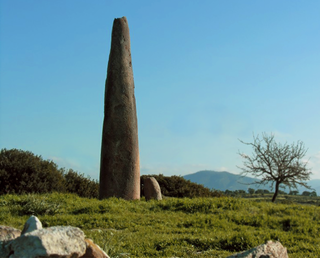
The Pre-Nuragic period refers to the prehistory of Sardinia from the Paleolithic until the middle Bronze Age, when the Nuragic civilization flourished on the island.
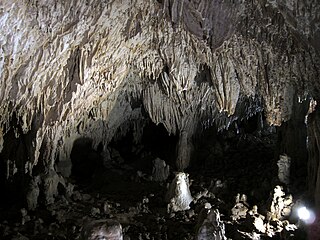
The Romito cave is a natural limestone cave in the Lao Valley of Pollino National Park, near the town of Papasidero in Calabria, Italy. Stratigraphic record of the first excavation confirmed prolonged paleo-human occupation during the Upper Paleolithic from 17,000 years ago and the Neolithic from 6,400 years ago. A single, but exquisite piece of Upper Paleolithic parietal rock engraving was documented. Several burial sites of varying age were initially discovered. Irregularly recurring sessions have led to additional finds, which suggests future excavation work. Notable is the amount of accumulated data that has revealed deeper understanding of prehistoric daily life, the remarkable quality of the rock carvings and the burial named Romito 2, who exhibits features of pathological skeletal conditions (dwarfism).

The Giorgio Asproni National Archaeological Museum is an archaeological museum in the historic centre of Nuoro, in Sardinia, near the Cathedral of Our Lady of the Snows. Established in 2002, it is located in a nineteenth-century building that belonged to Giorgio Asproni, a Sardinian politician and intellectual of that era.

